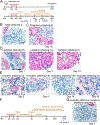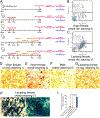Reversible De-differentiation of Mature White Adipocytes into Preadipocyte-like Precursors during Lactation
- PMID: 29909970
- PMCID: PMC6535147
- DOI: 10.1016/j.cmet.2018.05.022
Reversible De-differentiation of Mature White Adipocytes into Preadipocyte-like Precursors during Lactation
Abstract
Adipose tissue in the mammary gland undergoes dramatic remodeling during reproduction. Adipocytes are replaced by mammary alveolar structures during pregnancy and lactation, then reappear upon weaning. The fate of the original adipocytes during lactation and the developmental origin of the re-appearing adipocyte post involution are unclear. Here, we reveal that adipocytes in the mammary gland de-differentiate into Pdgfrα+ preadipocyte- and fibroblast-like cells during pregnancy and remain de-differentiated during lactation. Upon weaning, de-differentiated fibroblasts proliferate and re-differentiate into adipocytes. This cycle occurs over multiple pregnancies. These observations reveal the potential of terminally differentiated adipocytes to undergo repeated cycles of de-differentiation and re-differentiation in a physiological setting.
Keywords: adipose tissue; de-differentiation; lactation; mammary gland; preadipocyte.
Copyright © 2018 Elsevier Inc. All rights reserved.
Conflict of interest statement
DECLARATION OF INTERESTS
The authors declare no competing interests.
Figures




Comment in
-
Plasticity of fat cells.Nat Rev Endocrinol. 2018 Sep;14(9):504. doi: 10.1038/s41574-018-0053-x. Nat Rev Endocrinol. 2018. PMID: 29967402 No abstract available.
-
Cyclical Dedifferentiation and Redifferentiation of Mammary Adipocytes.Cell Metab. 2018 Aug 7;28(2):187-189. doi: 10.1016/j.cmet.2018.07.013. Cell Metab. 2018. PMID: 30089239 Free PMC article.
References
-
- Chen W, Gardeux V, Meireles-Filho A, and Deplancke B (2017). Profiling of Single-Cell Transcriptomes. Current protocols in mouse biology 7, 145–175. - PubMed
-
- Cinti S (2007). The adipose organ In Adipose tissue and adipokines in health and disease (Springer; ), pp. 3–19.
Publication types
MeSH terms
Grants and funding
LinkOut - more resources
Full Text Sources
Other Literature Sources
Molecular Biology Databases

